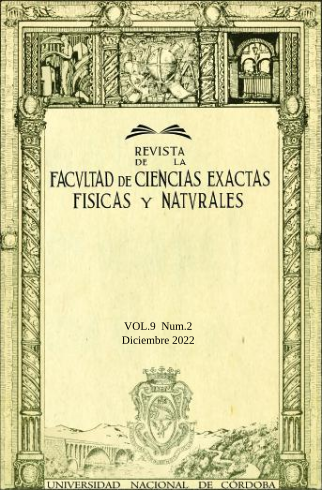La opinión de estudiantes universitarios en tiempo de pandemia
Keywords:
estudiantes, pandemia, clases virtuales, percepcionesAbstract
The present work is the result of the analysis of the answers given in an electronic questionnaire, by students of the first years of the careers that are dictated in the FCEFyN of the UNC, in relation to their perceptions and experiences before the abrupt step of the face-to-face course to the format of virtual classes, in the context of a pandemic and quarantine due to Covid-19. The responses analyzed show by the students a degree of positive assessment around their general experience in their transition from the face-to-face to the virtual, despite the abrupt and unexpected and the beginning of the continuous use of various technological resources, to many unknown and of varied implications.
Downloads
References
[1] Aquino, E. M. L., Silveira, I. H., Pescarini, J. M., Aquino, R., Souza-Filho, J. A. de Rocha, A. S., et al. (2020). “Medidas de distanciamento social no controle da pandemia de COVID-e19: potenciais impactos e desafios no Brasil”. Ciência & Saúde Coletiva, 25(1), 2423-2446. https://dx.doi.org/10.1590/1413-81232020256.1.10502020
[2] Barberá, E. y Badía, A. (2004). “Del profesor presencial al profesor virtual”. Educar en aulas virtuales: orientaciones para la innovación en el proceso de enseñanza y aprendizaje (p. 15-38). Madrid: Antonio Manchado libros S.A.
[3] Bekerman, U. y Rondanini, A. (2020). “El acceso a internet como garantía del derecho a la educación”. Diario DPI Suplemento Salud, 58, 1-7. http://dx.doi.org/10.2139/ssrn.3576719
[4] Beltrán, J., Venegas, M., Villar-Aguilés, A., Andrés-Cabello, S., Jareño-Ruiz, D. y de Gracia- Soriano, P. (2020). “Educar en época de confinamiento: La tarea de renovar un mundo común”. Revista de Sociología de la Educación, 13(2), 92-104. http://dx.doi.org/10.7203/RASE.13.2.17187
[5] Colás, P., González, T., De Pablos, J. (2013). “Juventud y redes sociales: Motivaciones y usos preferentes”. Comunicar, 40, 15-23. https://doi.org/10.3916/C40-2013-02-01
[6] Corrêa Filho, H. R., & Segall-Corrêa, A. M. (2020). “Lockdown ou vigilância participativa em saúde? Lições da Covid-19”. Saúde em Debate, 44(124), 5-10. https://doi.org/10.1590/0103-1104202012400
[7] Del Rincón, D., Arnal, J., Latorre, A., Sans, A. (1995). “Técnicas de Investigación en Ciencias Sociales”. Dykinson.
[8] Giannini, Stefania, (2020), “¡Todos unidos, ahora!” UNESCO: recuperado de https://es.unesco.org/news/todos-unidos-ahora
[9] Hammonds, F., Mariano, G. J., Ammons, G., & Chambers, S. (2017). “Student evaluations of teaching: improving teaching quality in higher education”. Perspectives: Policy and Practice in Higher Education.
https://doi.org/10.1080/13603108.2016.1227388
[10] Klemenčič, M. y Chirikov, I. (2015). “¿Cómo sabemos cómo los estudiantes experimentan la educación superior?” Sobre el uso de encuestas a estudiantes. En El espacio europeo de educación superior (págs. 361-379). Springer, Cham.
[11] Marinoni, G., Land, H. van’t, & Jensen, T. (2020). “The impact of COVID-19 on Higher Education around the world: IAU Global Survey Report”. Paris: International Association of Universities.
[12] Pavón, F. y Casanova, J. (2007). “Experiencias docentes apoyadas en aulas virtuales”. Revista Iberoamericana de Educación a Distancia, 10(2), 149-163. https://doi.org/10.5944/ried.2.10.997
[13] Rapanta, C., Botturi, L., Goodyear, P., Guàrdia, L., & Koole, M. (2020). “La docencia universitaria en línea durante y después de la crisis del Covid-19: reorientando la presencia docente y la actividad de aprendizaje”. Ciencia y educación posdigitales, 2 (3), 923-945.
[14] Silva, T. C., Oliveira, E. R., & Montanari, R. (2020). “Dificultades de la educación remota en las escuelas rurales del norte de Minas Gerais durante la pandemia de Covid-19”. Research, Society and Development, 9(8), e651986053-e651986053.
[15] Tarcízio, I. (2020). “Obstáculos do ensino à distância na rede pública durante a pandemia de Covid-19”. Socialismo Criativo. Disponible en: https://bit.ly/3ifJkl4
[16] Tenente, L. (2020). “Sem internet, merenda e lugar para estudar: veja obstáculos do ensino à distância na rede pública durante a pandemia de Covid-19”. Globo. Disponible en: https://glo.bo/3bK9n16
[17] Uttl, B., White, C. A., & Gonzalez, D. W. (2017). “Meta-analysis of faculty’s teaching effectiveness: Student evaluation of teaching ratings and student learning are not related”. Studies in Educational Evaluation, 54(Supplement C), 22–42. https://doi.org/https://doi.org/10.1016/j.stueduc.2016.08.007
[18] Vilches, L. (2011). “La investigación en comunicación”. Métodos y técnicas en la era digital. G
Downloads
Published
Issue
Section
License
Copyright (c) 2022 Facultad de Ciencias Exactas, Físicas y Naturales (Universidad Nacional de Córdoba)

This work is licensed under a Creative Commons Attribution 4.0 International License.
Los autores que publican en esta revista están de acuerdo con los siguientes términos:
Los autores conservan los derechos de autor y conceden a la revista el derecho de la primera publicación.
Los autores pueden establecer por separado acuerdos adicionales para la distribución no exclusiva de la versión de la obra publicada en la revista (por ejemplo, situarlo en un repositorio institucional o publicarlo en un libro), con un reconocimiento de su publicación inicial en esta revista.
Se permite y se anima a los autores a difundir sus trabajos electrónicamente (por ejemplo, en repositorios institucionales o en su propio sitio web) antes y durante el proceso de envío, ya que puede dar lugar a intercambios productivos, así como a una citación más temprana y mayor de los trabajos publicados (Véase The Effect of Open Access) (en inglés).



